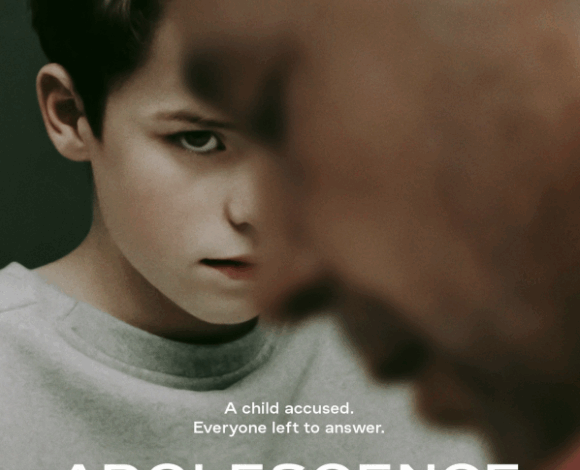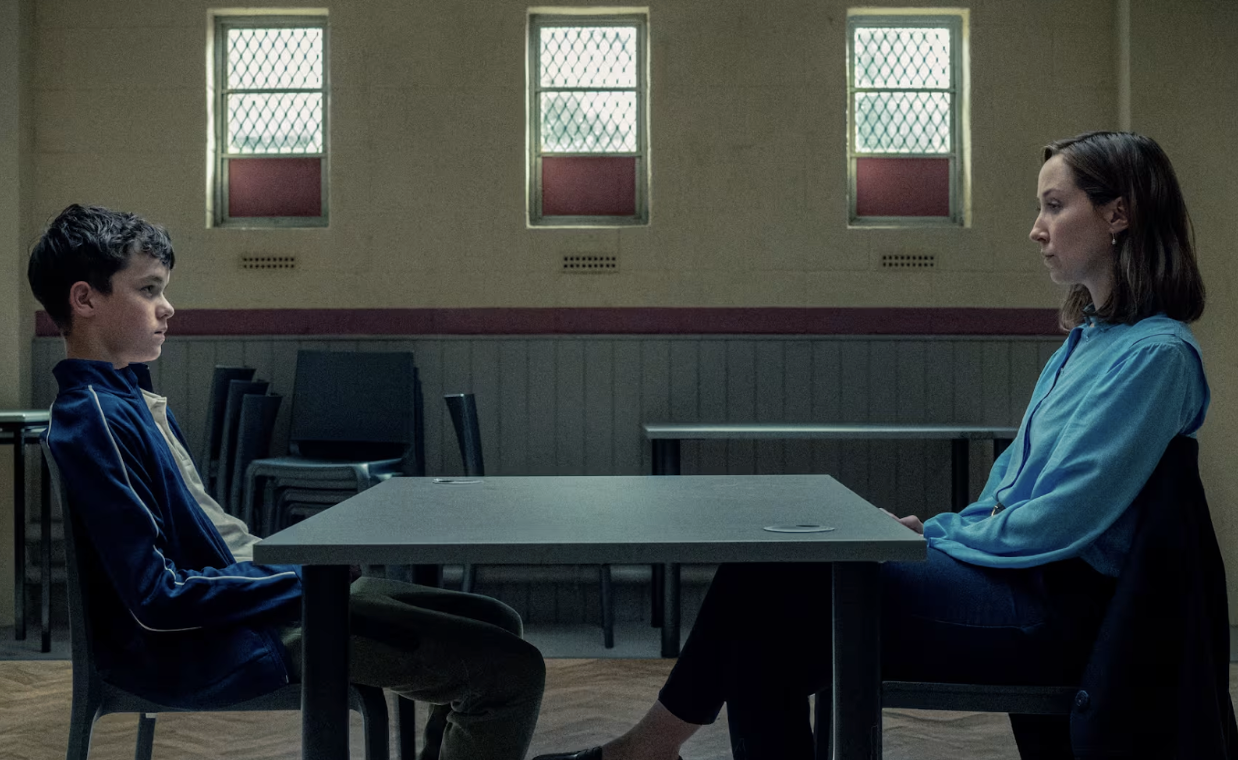Adolescence: One Take Wonder
The meticulous choreography of the camera and emotional deliveries is truly impressive

Meghan Boucher ‘27 / Emertainment Monthly Staff Writer
Minor spoilers ahead.
Boy kills girl. It’s a story far too popular in the media, but what if the boy was thirteen and what if the whole show was shot in one singular take? That’s the twist Netflix’s Adolescence has brought to screens. The show stars Owen Cooper in his first ever role as Jamie Miller, a 13 year old boy accused of murdering his classmate Katie. Right from the get go the show plummets the audience into a suspenseful rollercoaster.
The show opens with police barging into the Miller’s home and arresting Jamie right from his bedroom. As the police move through the house, the audience can feel the panic, fear, and confusion that is gripping the family. At first, the quick pacing and superb acting distracts from the fact that there hasn’t been one cut. No hidden cuts, no fade to black. Just one take all the way through. It is truly a testament to the writers and actors that their talent outshined a brilliant technical achievement. By the end of the first episode it’s apparent that there’s no way Jamie is getting out of this. So for the rest of the series, the question is why did he do it? And what does the fallout of such a crime have on the community, but also Jamie’s family? As the series progresses it all melds together, creating a masterpiece you can’t turn off. Being only four episodes, Adolescence seems to end as soon as it started. While it is a bingeable show with an impressive gimmick, that might be what leaves the audience craving more. The story feels limited because of the single shot weighing it down.
This is made apparent in the second episode, which follows the lead officers of the case D.I. Bascombe (Ashley Waters) and D.S. Frank (Faye Marsay), as they go to Jamie’s school to find answers. As the school day continues the audience sees how the tragedy has impacted Jamie’s classmates. While Katie’s friend Jade (Fatime Bojang) struggles to deal with the loss, other classmates around the school make crude jokes about the murder. As heartbreaking as the episode is, it’s a realistic portrayal of how children cope with loss and tragedy. Some act out, some use humor to cope, and others stay silent. Exploring how grief can grip a community, in all the various ways that may look, is such a compelling story arch. However, this element is especially limited because of the one take, as we only get brief glimpses into the fall out of the tragedy.
However, it can be overlooked because of the terrific performances from not only the adult actors, but also the child actors. The meticulous choreography of the camera and emotional deliveries is truly impressive. There is one instance where Bojang’s character, Jade, acts out violently at a group of classmates that taunt her. Her pure anger and sadness is palpable. The audience has to remind themselves that all these young actors have to walk that emotional tightrope for the entirety of the take. They lead us through a journey and do so with brilliant poise. While this episode isn’t the most suspenseful, knowing that there can’t be any mistakes made because of the single take leaves the audience marveling at the complexity of this show.
The incredible camera work in the last 10 minutes leaves the audience wondering how it was achieved. We’ve been following the characters throughout the school, and yet in the final few moments a chase breaks out. As it continues beyond school grounds, the camera goes from a handheld to a drone shot. It takes a second to realize what’s just happened as the transition was so seamless. However, the single shot feels especially limiting in this episode, as the characters and the audience never leave the school until the very end. This means that characters like Jade are never revisited. The audience only sees them for a brief moment and then never again, which leaves the characters feeling underdeveloped. But this disappointment doesn’t last for long.
Two of the most stellar performances in the show are Cooper, as Jamie, in the third episode and Stephen Graham, who plays Jamie’s dad, in the last episode. The third episode centers on Jamie and his conversation with psychologist Briony Ariston (Erin Doherty). As the tension builds, the audience learns of Jamie’s potential motives and he admits his crimes in a magnificent performance from Cooper. The show thus far has depicted Jamie as a sweet boy, he could be anyone you know and certainly not capable of murder. But in the episode’s climax, his anger explodes, terrifying both Ariston and the audience: it’s revealed that Jamie was being bullied online by Katie, who repeatedly called him an “incel.” It becomes increasingly apparent that Jamie has fallen victim to online internet culture and the “alpha male” mindset. Believing himself ugly, he seeks female approval and acts violently when it’s not reciprocated. A sad, but interesting look into how internet culture affects the youth of today. With so much exposure to all kinds of rhetoric online, young minds are influenced by the content they consume. Often, impressionable young people are allowed unrestricted access to anything on the internet. What this show asks is whose fault it is. Should parents be more attentive? Should there be stronger restrictions online? What are the warning signs to stop a tragedy before it happens? The last episode attempts to answer these questions.

After the explosive episode three, the audience is brought forward, 13 months after Jamie’s arrest and it’s his father’s birthday. This episode looks into how the tragedy of not only the murder, but of their own son committing such a crime has impacted the Millers. While they try to go about their day normally the neighborhood still judges them and sticks their noses in their business. Graham gives a dynamic performance, trying to keep a positive attitude, but ultimately succumbing to his anger at the situation and prying eyes of the community. Jamie’s parents have a tearful heart to heart where they ask themselves how much of this is their fault. They “created” Jamie and raised him. Is there something they could’ve done differently? Their guilt seeps through the screen and gives a compelling look into an aspect of a murder story that is never really shown. Oftentimes, and for good reason, a story of loss focuses on the victim. What Adolescence asks is can there be more than one victim? Are Jamie’s parents responsible or have they suffered a great loss too? It feels uncomfortable to ask these questions and ultimately the audience never gets a straight answer. We’re left in a sort of limbo, just as Jamie’s parents are, which lets us resonate with them more.
While Adolescence has some top notch acting and incredible technical achievements, there are still parts of it that leave more to be desired. It’s apparent that the real novelty of the show is the one take. As everything has to play out in real time some parts drag, while others seem to go by too fast. Bare bones, the story itself isn’t anything revolutionary. While the focus on the impact on the family is intriguing, the commentary about “incel” and internet culture feels very surface level. For being such a big part of the show, exploring this side of the internet and how it influences kids could have been really riveting, but it’s overlooked for the sake of the one take. Adolescence asks important questions about toxic masculinity and violence towards women, but when we’re only able to spend one hour with the characters, there isn’t enough time to unpack all the implications that arise from such questions. While short and sweet is sometimes better in storytelling, the series could have benefited from an additional episode. Maybe a flashback looking back on the events that led to Jamie’s decision, or even an episode that explores the parents’ reaction to the kind of content Jamie was engaging with. And yet both of these seem utterly impossible in the show’s context. A flashback episode would feel out of place and an episode dedicated to explaining internet “brain rot” would be incredibly boring with no cuts. The show did the best it could, but if scenes didn’t have to play out in real time, the issues the show raises could be more nuanced. Since much of the story is reliant on character development, it’s a little disappointing that the audience doesn’t get to see more about Jamie’s story. We don’t get to see any trial or get more insight into Jamie’s motives, which feels rare for a story about murder.
However, for a pretty typical narrative to be as addictive as this show is, there has to be something else: in this case it’s the performances and camera work, which are married so seamlessly and you can’t look away. In fact, maybe not getting all the answers or some epic conclusion is okay. The audience is left wanting more and wanting answers, which is exactly what the Millers want. As the audience goes through the story with the characters in real time, they’re also left with the same lack of closure as the characters. The show not only creates a story of grief that calls into question our current culture, but does so with an expert level of craftsmanship. While it may not answer all the questions it creates, Adolescence mirrors the unresolved pain of real life tragedy, which creates a brilliant, bingeable show.